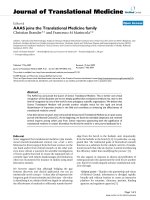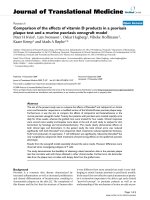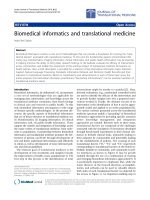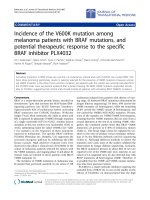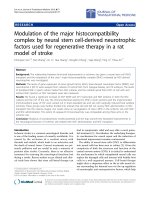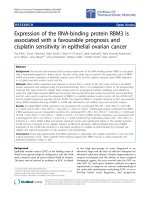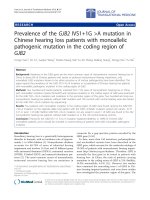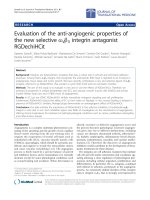báo cáo hóa học:" AAAS joins the Translational Medicine family" pot
Bạn đang xem bản rút gọn của tài liệu. Xem và tải ngay bản đầy đủ của tài liệu tại đây (180.78 KB, 2 trang )
BioMed Central
Page 1 of 2
(page number not for citation purposes)
Journal of Translational Medicine
Open Access
Editorial
AAAS joins the Translational Medicine family
Christian Brander*
1
and Francesco M Marincola*
2
Address:
1
Laboratori de Retrovirologia, Fundació irsiCaixa Hospital Universitari Germans Trias i Pujol Ctra del Canyet s/n 08916 Badalona, and
Institució Catalana de Recerca i Estudis Avançats, Barcelona, Catalonia, Spain and
2
Infectious Disease and Immunogenetics Section (IDIS),
Department of Transfusion Medicine, Clinical Center, and Center for Human Immunology (CHI), National Institutes of Health, Bethesda,
Maryland, 20892, USA
Email: Christian Brander* - ; Francesco M Marincola* -
* Corresponding authors
Abstract
The AAAS has announced the launch of Science Translational Medicine. This is further and critical
recognition of this discipline and we are deeply gratified that translational medicine has risen to the
level of recognition by one of the world's most prestigious scientific organizations. We believe that
Science Translational Medicine will provide another valuable venue for the rapid and broad
dissemination of important articles in the field and contribute to enhancing the effectiveness of
translational medicine overall.
It has been almost six years since we launched the Journal of Translational Medicine as an open-access
journal with Biomed Central [1]. At the beginning, we faced the inevitable skepticism and received
several inquires among others also from Science reporters questioning both the significance of
translational medicine in today's biomedical world and the need for a new journal dedicated to it.
Editorial
Some suggested that translational medicine (aka transla-
tional research/translational science) was a fad: a term
fabricated to divert support from the basic sciences on the
one hand and/or from clinical research on the other and,
even more critical, a synonym for scientific investigations
of lower quality that tried to excuse the supposed lack of
scientific rigor with inherit disadvantages and limitations
often not encountered for instance in studies using small
laboratory animals.
We however argued that although bridging the gap
between discovery and clinical application was not an
intrinsically novel concept – it does after all represent the
long term goal of most scientists and clinicians – the value
in identifying it as a distinct field was largely in enhancing
the effectiveness of methods to efficiently transfer knowl-
edge from the bench to the bedside, and, importantly,
from the bedside to the bench [2-4]. In particular, we sug-
gested that "the traditional goals of biomedical research
function as a substrate for the catalytic activity of transla-
tional research that, like an enzyme, is aimed at enhancing
the efficiency rather than modifying the process" [3].
We also argued, in response to editors and publishers of
existing journals who questioned the need for yet another
one, that JTM would uniquely advance translational med-
icine through:
1) Open access – Thanks to the partnership and vision
of BioMed Central, information is divulged rapidly,
broadly and without barriers to create an interactive
platform for scientists, clinicians, patients, funding
agencies and regulatory agencies [5].
Published: 7 May 2009
Journal of Translational Medicine 2009, 7:32 doi:10.1186/1479-5876-7-32
Received: 19 April 2009
Accepted: 7 May 2009
This article is available from: />© 2009 Brander and Marincola; licensee BioMed Central Ltd.
This is an Open Access article distributed under the terms of the Creative Commons Attribution License ( />),
which permits unrestricted use, distribution, and reproduction in any medium, provided the original work is properly cited.
Publish with Bio Med Central and every
scientist can read your work free of charge
"BioMed Central will be the most significant development for
disseminating the results of biomedical research in our lifetime."
Sir Paul Nurse, Cancer Research UK
Your research papers will be:
available free of charge to the entire biomedical community
peer reviewed and published immediately upon acceptance
cited in PubMed and archived on PubMed Central
yours — you keep the copyright
Submit your manuscript here:
/>BioMedcentral
Journal of Translational Medicine 2009, 7:32 />Page 2 of 2
(page number not for citation purposes)
2) A specialized Editorial Board consisting exclu-
sively of translational scientists and physicians with
expertise in both the clinic and in the laboratory. We
felt that only individuals with combined expertise
could authoritatively and constructively discriminate
between good and bad clinical science. Clinical stud-
ies are often limited by necessity due to practical,
financial and ethical constraints; yet they have tremen-
dous value because they provide insights to the actual
reality of disease [1]. These insights can often times
not be gained in in-vitro analyses only or by experi-
mentation in animal models. Thus, the Board was
selected not only according to individual achievement
but also according to their demonstrated enthusiasm
and dedication to the field, knowing that many board
members would face some sort of skepticisms by their
peers.
3) An equal interest in descriptive and mechanistic
studies. It is our conviction that knowledge about
human disease is limited and a bottom-up inductive
approach (i.e. assessing human diseases in patients
and patient samples) represents a preliminary step
that should be valued as much as elegant mechanistic
studies, which can be of limited relevance to human
disease [6].
The Journal of Translational Medicine has done so well in
part because the significance of this emerging discipline
has become widely accepted. We contend that transla-
tional medicine will be increasingly central to the identi-
fication of novel products with potential therapeutic
value. Translational strategies may respond to the need to
test novel therapies with solutions that address the enor-
mous costs of clinical research, the lack of reliable pre-
clinical models that could help prioritize products for
clinical testing, the lack of predictive biomarkers that
could help patient selection and the lack of surrogate
biomarkers that could help with the assessment of prod-
uct efficacy early in development.
All of us who have been dedicated from the beginning to
this important field applaud the recent announcement by
the American Association for the Advancement of Science
that it is launching Science Translational Medicine [7]. We
are deeply gratified that translational medicine has risen
to the level of recognition by one of the world's most pres-
tigious scientific organizations. Yet, Science Translational
Medicine will actually be a closed access title, quite a sig-
nificant obstacle to the discipline-barrier-breaking spirit
which progress in translational research depends on. We
reiterate the benefits of openness – not least as evidenced
by the NIH Open Access policy which is now both man-
datory and non-time-limited – which JTM offers. Never-
theless, we believe that Science Translational Medicine will
provide another valuable venue for the rapid and broad
dissemination of important articles in the field and con-
tribute to enhancing the effectiveness of translational
medicine overall.
References
1. Marincola FM: Translational medicine: a two way road. J Transl
Med 2003, 1:1.
2. Mankoff SP, Brander C, Ferrone S, Marincola FM: Lost in transla-
tion: obstacles to Translational Medicine. J Transl Med 2004,
2:14.
3. Littman BH, Di Mario L, Plebani M, Marincola FM: What's next in
Translational Medicine? Clin Sci (Lond) 2007, 112:217-227.
4. Horig H, Marincola E, Marincola FM: Obstacles and opportunities
in translational research. Nat Med 2005, 11:705-708.
5. Lotze MT, Gray J: A Life in Passing: Jonathan Gray. J Transl Med
2007, 5:54.
6. Marincola FM: In support of descriptive studies: relevance to
translational research. J Transl Med 2007, 5:21.
7. AAAS Science Translational Medicine 2009 [
encemag.org/marketing/stm].


